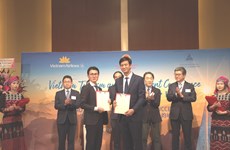Ba Ria-Vung Tau: Oyster farming brings stable incomes to locals
Oyster farming has really become a major source of income for farmers living in Long Son island commune in the southern coastal province of Ba Ria-Vung Tau. Ironically, they have developed this aquaculture industry accidentally while rearing other fisheries sources.
 Illustrative image (Source: internet)
Illustrative image (Source: internet)It is interesting to discover that Long Son farmers expanded oyster cultivation after realizing that saltwater clams would cling to the cages of farmed fish and shrimp. This inspired the idea of raising and processing oysters to be sold as a high source of nutrition.
Thanks to its proximity to sea, Long Son waters have favourable natural conditions for oyster farming, with year-round warm temperatures and acceptable levels of salt.
According to Ms. Le Kim Thoa, Director of the Sea and Island Research Centre under the Vietnam National University in Ho Chi Minh City, Long Son island commune has a large mangrove forest area which is home to various ephemeral organisms serving as natural food for oysters.
Long Son farmers raise oysters in cages and on pales. The aquaculture does not require large investments but it generates high income for locals.
No feed is needed to raise oysters because they grow by absorbing various ephemeral organisms. Meanwhile the oyster breeding does no harm to the environment.
However, local oyster breeders have faced many poor yields after river water is affected by hazardous waste from surrounding factories.
“We can harvest oysters after one year of aquaculture and have another crop in the following months,” said Mr. Nguyen Le Hung, a farmer from Long Son commune.
“Difficulties emerge from raising oysters on pales because we only harvest them when the tide ebbs. These days, we have earned some low yields since the water is polluted,” Hung added.
Long Son oysters weigh up to 300grams, much larger than those adrift at sea. Therefore, it can be hard to lift them without support.
The third lunar month is the best time to enjoy dishes created from fresh oysters, and so the consumption of Long Son oysters peaks at this time of year.
A few farmers have tried combining oyster raising with other aquaculture and fish rearing.
More than 700 households in Long Son commune form a combined farming area of 750 ha, yielding around 6,000 tonnes of seafood. They can earn some 500 USD a year from each oyster cage, bringing their annual income to 5,000 USD with 10 oyster cages.
Living standards of local residents have been much improved thanks to stable income generated from the oyster aquaculture.
Director Le Kim Thoa said economic benefits generated from oyster breeding helps improve living standards of local people while the commune’s infrastructure has been improved.
Oysters raised in Long Son commune are sold at farms and often processed into dishes to serve tourists at some floating houses on the Rang river.
We can enjoy fresh oysters with some slice of lemon and sauces including red pepper.
Mr. Vo Van Mui, Chairman of the Long Son communal People’s Committee, said the Long Son oyster brand is quite popular in Ba Ria - Vung Tau province and Ho Chi Minh City. The locality plans to protect and promote the brand.
It is worrying, however, that Long Son farmers only pay attention to making profits from the aquaculture and do not realise the significant role of oyster in maintaining the bio-diversity of the marine ecosystem.
Scientists suggested it is advisable to apply advanced technologies in practising oyster aquaculture while looking towards the sustainable development of oyster farming./.













